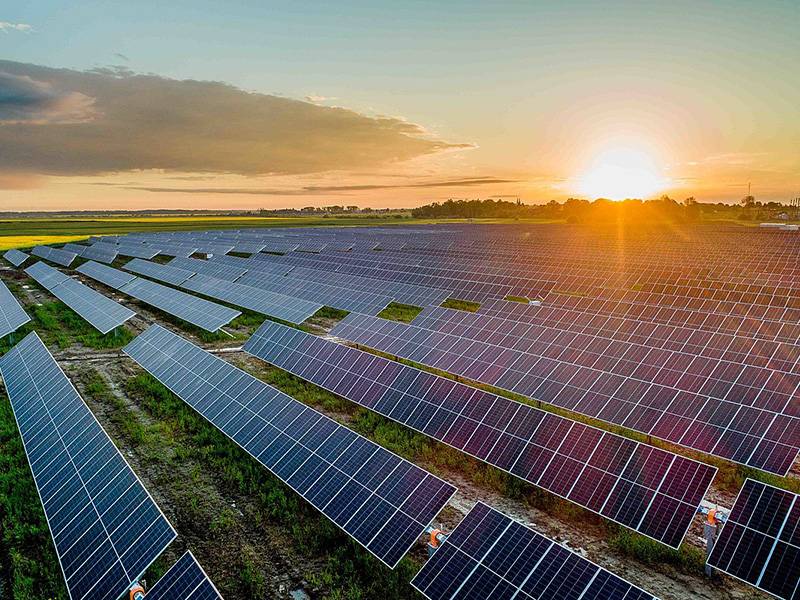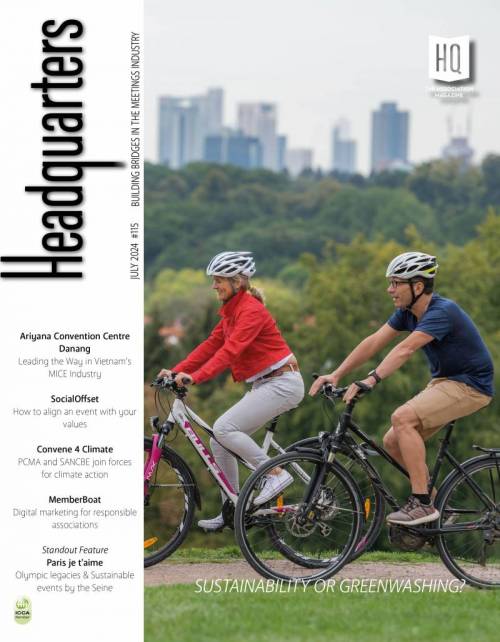SolarPower Europe: “By 2030, we could free Europe from Russian gas with Solar”

SolarPower Europe is the legitimate link in the dialogue between policy makers and the solar PV value chain, representing 260 organisations across the sector. Its mission is to ensure that solar becomes Europe’s leading energy source by 2030, and lead this transition towards a smart, sustainable and secure network. We spoke to CEO Walburga Hemetsberger and Head of Events & Marketing Charlotte Otten, about how the sun can power our energy consumption, lower our electricity bills, and provide a reliable and secure source of endless energy.
1) As a member-led association representing several national organisations, how have you overcome these difficulties and dealt with the “new normal”?
 Walburga Hemetsberger (right side): The pandemic fundamentally changed the way we work. In the beginning of the pandemic there were many unknowns. Our foremost concern was the safety and well-being of our team, members and partners. Working remotely presented a fair share of challenges but also opportunity. During the pandemic, we launched the ‘Shine On’ digital series, featuring podcasts, webinars and executive interviews with EU policymakers. We also hosted several events online, from SolarPower Summit, Solar Quality to RE-Source. The pandemic has taught us many lessons; remote working can be highly effective, it forced us to think more creatively, it underlined the importance of our mental and physical well-being, being kind and empathetic towards each other. And let’s not forget digital skills! The SolarPower team became MS Team and Zoom experts in record time, these platforms are an integral part of the way we work today and for the forseeable future.
Walburga Hemetsberger (right side): The pandemic fundamentally changed the way we work. In the beginning of the pandemic there were many unknowns. Our foremost concern was the safety and well-being of our team, members and partners. Working remotely presented a fair share of challenges but also opportunity. During the pandemic, we launched the ‘Shine On’ digital series, featuring podcasts, webinars and executive interviews with EU policymakers. We also hosted several events online, from SolarPower Summit, Solar Quality to RE-Source. The pandemic has taught us many lessons; remote working can be highly effective, it forced us to think more creatively, it underlined the importance of our mental and physical well-being, being kind and empathetic towards each other. And let’s not forget digital skills! The SolarPower team became MS Team and Zoom experts in record time, these platforms are an integral part of the way we work today and for the forseeable future.
The solar market was impacted by the pandemic, mostly in terms of supply chain disruptions. Despite COVID-19, solar has continued to grow, demonstrating its resilience and reliability. In 2021, the European Union has seen an estimated 25.9 GW of new solar PV capacity connected to the grid, an increase of 34% over the 19.3 GW installed in 2020. We must not forget the lessons from the pandemic, build back greener and deploy more solar faster than ever before.
2) Can you please introduce us to the SolarPower Europe’s Sustainability Task Force?
WH: Our Sustainability work stream attempts to influence EU legislation related to solar PV sustainability, and highlight the best performance of solar sustainability to policy makers and the broader public. This workstream is particularly active on Ecodesign and Energy Label policy proposals for solar PV products, with the purpose of ensuring the implementation of strong and future-proof measures for the EU solar sector. In 2021, the workstream published the “Solar Sustainability Best Practices Benchmark”, focusing on case studies and best practices along the solar value chain. The report aims to guide and accompany solar companies in demonstrating thought leadership in sustainability. The Sustainability workstream consists of over 50 members and is chaired by Matthew Merfert of First Solar.
3) How challenging was the organisation of the SolarPower Summit in this post-pandemic period?
 Charlotte Otten (left side): Although the pandemic is still very much present in Belgium, we had more clarity this year about the rules and regulations that we had to follow. Nevertheless, a few weeks before the event, there were still many regulations in place that prevented us from organising the event exactly as we had planned. For instance, there was a maximum capacity restriction of 200 attendees, COVID safe ticket scans, and tight rules on food service. We were fortunate that the Belgian government had lifted all these measures shortly before the summit took place on 31 March. While the organisation remained a challenge, we learned to be more flexible with last minute changes and always prepare alternative plans. On the attendee side, we saw a strong willingness from our members and stakeholders to travel and attend the event in person, recording a higher attendance than any previous edition of the SolarPower Summit.
Charlotte Otten (left side): Although the pandemic is still very much present in Belgium, we had more clarity this year about the rules and regulations that we had to follow. Nevertheless, a few weeks before the event, there were still many regulations in place that prevented us from organising the event exactly as we had planned. For instance, there was a maximum capacity restriction of 200 attendees, COVID safe ticket scans, and tight rules on food service. We were fortunate that the Belgian government had lifted all these measures shortly before the summit took place on 31 March. While the organisation remained a challenge, we learned to be more flexible with last minute changes and always prepare alternative plans. On the attendee side, we saw a strong willingness from our members and stakeholders to travel and attend the event in person, recording a higher attendance than any previous edition of the SolarPower Summit.
4) Considering that several countries are at different paces of implementation and many of them are still clinging to their own fossil resources, how can solar energy stir up a carbon-neutral economy in Europe?
WH: Solar is today the most low-cost and easily deployed clean energy technology, and can be installed almost anywhere. It is also Europe's fastest growing energy technology, even if it is only at the beginning of harvesting solar’s enormous potential and benefits in Europe. Today, more than 90% of roofs in Europe go unused when they could help mitigate climate change by having solar panels on them. It is assumed that deploying solar on all suitable roofs in the EU could meet around 25% of the EU's annual electricity consumption.
With solar energy we can accelerate the energy transition, champion sustainable growth and innovation, create new green jobs and help deliver a climate neutral Europe before 2050. The Intergovernmental Panel on Climate Change (IPCC) has warned us that we are entering a code red for humanity: 2°C of warming will be exceeded this century unless we make deep reductions in GHG emissions. Solar energy is poised to help tackle the climate crisis, but we still need to ensure there are no barriers to our technology’s growth by making licensing procedures easier.
5) Could the war in Ukraine be another step towards clean and sustainable energies over fossil fuels?
WH: The Russian war in Ukraine has reshuffled the deck, and highlighted the EU’s need for energy security and independence. SolarPower Europe condemns this Russian war, and is working with the Solar Energy Association of Ukraine to support the nation’s power infrastructure needs. With the right support, solar is ready to step up and help the continent move away from Russian gas. In the short term, we can deliver 39 GW of additional EU solar power this year – 13 more than last year. By 2030 we could reach the ‘terawatt’ level of EU solar – over 1000 GW total capacity – and free Europe from Russian gas almost entirely.
What is crucial is to fast-track European solar PV manufacturing to head demand and ensure our energy independence. SolarPower Europe has launched the European Solar Initative, an industrial alliance for solar with its partner EIT InnoEnergy, that aims to achieve at least 20 GW of annual production capacity by 2025.
Social Economy Europe: “No growth is worthwhile unless it is underpinned by sustainability”
6) What kind of campaigns SolarPower Europe is working on at the moment?
CO: SolarPower Europe in partnership with ten other renewable energy and city associations, with the endorsement of scientists from the IPCC and leading universities, has launched a campaign calling for the EU to endorse a minimum 45% renewable energy target by 2030. A higher renewable energy target is necessary to meet our Paris Agreement commitments and to increase our energy independence.
SolarPower Europe has also launched #SolarWorks, a campaign to highlight the diverse job opportunities in the European solar sector. In a 5-part video series, we speak with solar workers in the fastest growing European markets about their motivation and advice for starting a career in the industry. Along those lines, together with ‘Grow with Google’, we created a website featuring training programmes to get started in solar.
7) What main events do you have scheduled for this year? Would you like to tell us a little about it?
CO: Coming up in the Autumn, it is the RE-Source event which is the annual gathering of corporate buyers and clean energy suppliers. Every year, it gathers 1,000 people from companies like IKEA, Philips, Vodafone, Heineken, Google, Decathlon, Microsoft, Amazon, and many more to share experiences and best practices, connect buyers and sellers and bring solutions to make sure corporate demand is met with the renewable supply that is needed. This year, RE-Source will take place on 6-7 of October 2022, in Amsterdam at the Okura Hotel.
Other Articles
About Us
Supported by the Union of International Associations (UIA), the International Association of Professional Congress Organisers (IAPCO) and the Interel Group, the global public affairs and association management consultancy, Headquarters Magazines serve the needs of international associations organising worldwide congresses.















